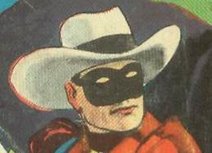Comics have their myths as well. The Yellow Kid was the first newspaper strip. Famous Funnies was the first comic book. We all know those are not quite true either.
One of my favorites is how a salesman at Eastern Color printing, M.C. Gaines, took a handful of giveaway comics, stuck a 10 cent price sticker on then, dropped them off at some newsstands and invented the industry. There is probably some truth to the story and the impact of that experiment did ultimately lead Gaines to publishing and he influenced others to give it a try too.
One of those was George Delacourt. This was Delacourts second attempt at comics. In 1929 he published The Funnies, which according to Ron Goulart was more like a newspaper tabloid than a comic book. The book was 24 pages in length, issued weekly and sold for 10 cents. After 36 issues Dell called it quits.

Gaines was employed at the McClure Syndicate by 1935 and there packaged Dell's first true comic book, Popular Comics cover dated Feb 1936. Popular followed the Famous Funnies formula of offering reprints of established newspaper strips such as Dick Tracy, Skippy, Mutt and Jeff (a Gaines favorite, he printed M&J under his All American line), Little Orphan Annie, Tailspin Tommy, The Gumps, Don Winslow of the Navy, Bronc Peeler, Smokey Stover, Terry and the Pirates and Ripley's Believe it or Not.
This also established a pattern for Dell, for the next 30 odd years they purchased the comics they published as a package. The primary supplier was Western Publishing and Lithographing Company. Western took over packaging Popular and appointed Oskar Lebeck as editor.
Gaines packaged Dell's second book, resurrecting The Funnies as the title and cover dated October 1936. In 1937 Dell published The Comics and in 1938 added Crackajack and Super Comics to their list of titles.
All these titles were anthology titles consisting of newspaper reprints, original strips produced by Western and licensed properties from Stephen Slesinger.

Along with Dell and Eastern Color's Famous Funnies, United Features published anthology titles reprinting newspaper strips that they syndicated. Tip Top comics first appeared in 1936 followed by Comics on Parade in 1938. The David McKay Company of Philadelphia published comic strips syndicated by King Features beginning in 1936 with King Comics. They added Ace Comics in 1937 and Magic Comics in 1939.
Each of these publishers launched an omnibus title where they would feature an individual strip. The advantage to these books is that in the case of continuity strips an entire story would be printed. In the anthology books most strips would get 2 to 4 pages in each issue. You were pretty much following at the same pace as the Sunday paper except you got 4 weeks once a month instead of one week at a time.

There was more precedence for these single character books. Foxy Grandpa and Buster Brown appeared in more than a dozen books reprinting their Sunday adventures between 1901 and 1917. Many of these were published by the newspapers themselves. Heart's New York Journal printed 5 in 1902. Available from all the Hearst papers nationwide were titles like The Katzenjammer Kids and Happy Hooligan. Hearst passed the publishing rights over to the Frederick A Stokes Company in 1904 who continued to issues books of Hearst strips until 1916.
In 1906, New York publisher Couples and Leon began publishing. By the time they quit in 1934 they had produced over 100 different issues. Their most popular title was Bringing Up Father, who appeared in 26 different books. Other collections included Little Orphan Annie, Mutt and Jeff, The Gumps, Tillie the Toiler and Smitty.

In January 1922 Embee Distributing published the first issue of the Comic Monthly. Unlike the C&L books this was closer to the Comic Book format that evolved in the 1930's. Each month a different Hearst strip was featured beginning wit Polly and Her Pals. Comic Monthly lasted for a year before it ceased publishing.

David McKay was the first publisher to print an omnibus issuing Feature Book in 1937. The first issue was unnumbered and titled Dick Tracy the Detective. Zane Grey's King of the Royal Mounted was the first numbered issue, cover dated May 1937. A large book at 9x12 and 64 pages it reprinted the newspaper strip.
United Features followed with their Single Series in 1939, with the Captain and the Kids, Fritzi Ritz, Broncho Bill, Ella Cinders and Li'l Abner among the featured titles.
Dell entered the omnibus race in 1939 with the Large Feature Comic, an oversize book that mixed issues with newspaper reprints like Dick Tracy and Terry and the Pirates and illustrated text stories like issue #7 entitled Hi-Yo Silver The Lone Ranger to the Rescue. These were black and white with color covers. But Sept 1939 also marked Dell's first Four Color Comic, Dick Tracy #1, 68 pages all in color. A total of 25 issues appeared on the stands mostly reprinting newspaper strips. Disney produced two issues that showcased animated cartoons, #13's The Reluctant Dragon and # 17's Dumbo.
In 1942, Dell started the numbering for the Four Color Comics over with #1 Little Joe, reprinting the newspaper strip. Series II continued until Summer 1962 with a total of 1322 issues. Issue 1329 was believed to be issued with the number 01329-207. Issue 1354 Calvin and the Colonel was the final issue published. Issues with 1331,1334,1338-1340,1342-1347 and 1351-1353 were never printed.
Reference: Grand Comics Database www.comics.org; Over 50 Years of American Comic Books, Ron Goulart, Mallard Press 1991; The International Book of Comics, Denis Gifford,Crescent Books 1984


No comments:
Post a Comment